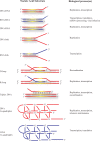The biology of DHX9 and its potential as a therapeutic target
- PMID: 27034008
- PMCID: PMC5173168
- DOI: 10.18632/oncotarget.8446
The biology of DHX9 and its potential as a therapeutic target
Abstract
DHX9 is member of the DExD/H-box family of helicases with a "DEIH" sequence at its eponymous DExH-box motif. Initially purified from human and bovine cells and identified as a homologue of the Drosophila Maleless (MLE) protein, it is an NTP-dependent helicase consisting of a conserved helicase core domain, two double-stranded RNA-binding domains at the N-terminus, and a nuclear transport domain and a single-stranded DNA-binding RGG-box at the C-terminus. With an ability to unwind DNA and RNA duplexes, as well as more complex nucleic acid structures, DHX9 appears to play a central role in many cellular processes. Its functions include regulation of DNA replication, transcription, translation, microRNA biogenesis, RNA processing and transport, and maintenance of genomic stability. Because of its central role in gene regulation and RNA metabolism, there are growing implications for DHX9 in human diseases and their treatment. This review will provide an overview of the structure, biochemistry, and biology of DHX9, its role in cancer and other human diseases, and the possibility of targeting DHX9 in chemotherapy.
Keywords: DExD/H-box; DHX9; Maleless; RNA helicase A; helicase.
Conflict of interest statement
The authors declare no conflicts of interest.
Figures



References
-
- Zhang S, Grosse F. Nuclear DNA helicase II unwinds both DNA and RNA. Biochemistry. 1994;33:3906–3912. - PubMed
-
- Eckhard J, Fairman-Williams ME. An introduction to RNA helicases: superfamilies families and major themes. In: Jankowsky E, editor. RNA Helicases. Cambridge UK: Royal Society of Chemistry; 2010. pp. 1–31.
-
- Cordin O, Banroques J, Tanner NK, Linder P. The DEAD-box protein family of RNA helicases. Gene. 2006;367:17–37. - PubMed
-
- Singleton MR, Dillingham MS, Wigley DB. Structure and mechanism of helicases and nucleic acid translocases. Annu Rev Biochem. 2007;76:23–50. - PubMed
Publication types
MeSH terms
Substances
LinkOut - more resources
Full Text Sources
Other Literature Sources
Miscellaneous

